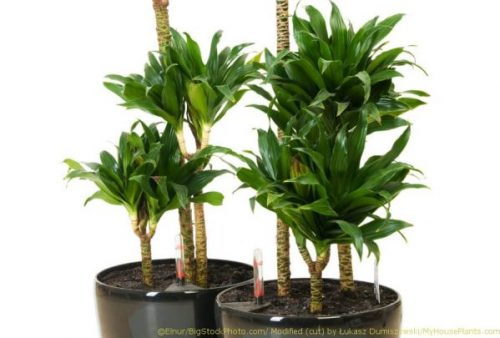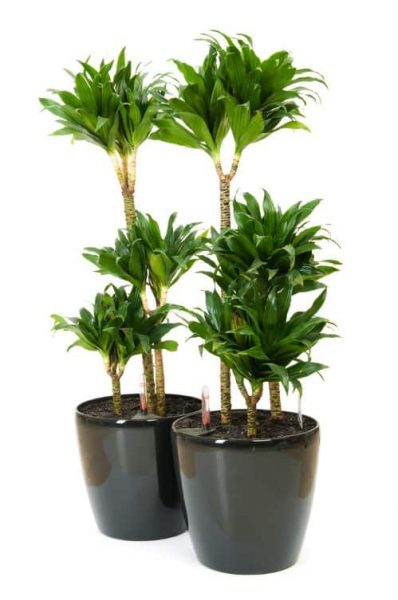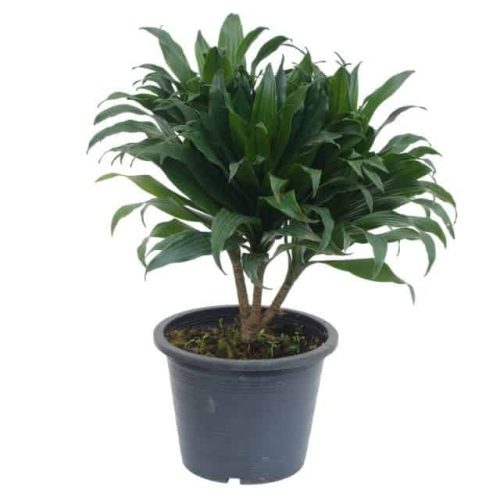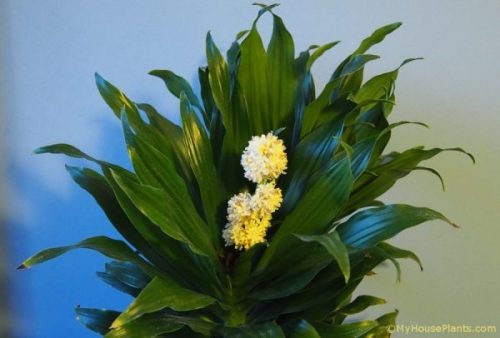Dracaena fragrans Compacta – Your Complete Care Guide
Due to its stylish appearance suiting modern apartments Dracaena Compacta is one of the most well loved houseplants. According to many popular views it is also a plant that is quite easy to grow. Unfortunately, popular views are not always true, as I found out for myself when wondering for a long time why my dracaenas looked so miserable.
The Dracaena Compacta is believed to be a variety of dracaena deremensis ‘Janet Craig’. Compacta is smaller and more compact, and it grows much more slowly.

Care
If I had to write only one sentence about looking after the Dracaena Compacta, it would probably be something like this: “It is easy enough to grow the Dracaena so it survives many years, but it is hard to make it thrive and its leaves not to yellow and drop.”
The most important thing when growing the Dracaena Compacta is to be aware of the close relationship between the intensity of available light, the air humidity, the substratum moisture and the temperature. The relationship between these parameters is of course important for all flowers but in the case of the Dracaena Compacta you should have it particularly in mind. Any change to one these parameters should be reflected by the proper adjustment of all the rest.
Let’s start with the most important issue for every plant, namely light.
Light
You can come across opinions in books or on the Internet that the Dracaena Compacta is not particularly light-loving. Well, actually, this is not true. Without the appropriate amount of light the plant stops growing and its leaves start to yellow and drop(starting from those at the bottom as a general rule).
Don’t worry if your Dracaena Compacta sheds a few of its lower leaves during the year. However, if it sheds a few in the course of any given month, it means that either it is sick or it is growing in unfavourable conditions.
In summer the ideal place for the Compacta will be the windowsill of an east- or west-facing window. In other seasons of the year the best choice will be a south-facing window. However, even this can turn out not to be bright enough on short winter days. In such a case a good idea may be to use artificial light. (Ideally, the duration and intensity of lighting the Dracaena should be more or less constant every day throughout the year, as it is the case in its natural habitat).
It is also very important that the light reaches every part of the plant, because otherwise the leaves on the unlit side will start to yellow. To guarantee the flower is evenly lit, rotate it 180° every day.
Watering
The frequency of watering the Dracaena Compacta depends on the season of the year or, more accurately, on the amount of available light. In summer you should water the Dracaena more often, in winter (especially when the temperature in the room is lower) you ought to do it less often.

Only ever water the Dracaena when the soil in the pot has almost completely dried out. Too moist a substratum will cause the leaves to yellow and can also make the roots rot and the plant die (which happened once to one of my specimens as a matter of fact). Ideally, the soil in which the Dracaena Compacta grows should only ever be minimally moist, almost dry, at any depth in the pot. Almost dry, that is, not bone-dry, because this will cause the tips of the leaves to dry out.
Water the plant until excess water flows into the saucer, wait 2 minutes, then pour the remaining water out of the saucer so that the soil in the pot does not soak up too much. In addition, use permeable soil, thus avoiding it becoming too heavily soaked when watering.
Feeding
The Dracaena Compacta grows slowly, therefore it is not necessary to feed it, especially when the soil in the pot is fresh. However, If the plant has not been repotted for a few years, you can feed it with some fertilizer for green plants in spring and summer every 1 – 2 months.
Air humidity
As far as the Dracaena Compacta is concerned the proper level of air humidity is as important as the amount of available light and how much it is watered. The rule of thumb is this: the higher the humidity, the better. No matter what light you provide the Dracaena with, or how regularly you water it, the leaves of the Compacta will dry out and drop off if the humidity of the air around it is low (below 50%). This can easily happen in temperatures below 20°C. A situation like this can often occur in the heating-season in winter, when it is dry and warm in the flat; the humidity falls below 40% and the temperature stays on the high side.
To provide the plant with sufficient humidity, sprinkle it with water at least twice a day if the air humidity in the home goes below 50%. If the air humidity is higher, you can limit the misting to once every 1 – 2 days.
You can buy a simple hygrometer, which will allow you to measure the air humidity in your room, for about 10$.
Of course, if you have neither the time nor the inclination to sprinkle the plant by hand, you can use an air humidifier.
Temperature
In winter, when there is less light, the temperature should be lower, about 18°C/ 65°F (remember to limit the watering). In summer the temperature should be higher, preferably around 24°C (75°F).
Repotting
Every spring check to see if the roots of the plant fill the pot and if so, repot the Dracaena to a pot which is 2 – 4 cm (1 – 2 in) wider in diameter. In the case of larger or older specimens growing in big pots it would be enough simply to replace the top few centimetres of soil.

Pruning
Pruning the tips of the Dracaena Compacta makes a real difference to its appearance. Without cutting, this plant hardly ever branches out at all. The rosette of leaves grows upwards and remains relatively unattractive. Cutting the plant tips off in spring makes the flower sprout nicely and take on a dense and bushy form.
Cut off the growing tips every 2 years in the spring. After a few weeks the plant will sprout 2, 3 or even 4 new leaf rosettes in the place it was cut. It is worth noting that you can use the severed tips to propagate the plant.
Propagation
The simplest way to propagate the Dracaena Compacta is with tip cuttings. In order to do this you can use the tips that have been cut off the plant to make it branch out (see above, the paragraph on pruning).
Another method is to allow an 8 centimeter long piece of the cane (stem) to root in a humid atmosphere at a temperature above 22°C/ 71°F (by laying it on the soil).
Pests / diseases
None of my Dracaenas have been infested by any pest during the several years of my growing them. However, you can come across an opinion that mealybugs, scales or spider mites can sometimes feed on them. If this happens, just use an appropriate insecticide (you will find more information on this topic in the section “house plant diseases”).
In some sources you can read that the Dracaena is subject to fungous diseases, for example tan spots. Fighting them very often ends in failure, although you can deal with some fungus species by using appropriate fungicides (depending on the fungus, I am not an expert here).
Another problem which is often raised about the Dracaena Compacta is its high sensitivity to excess fluoride or chloride in the water that is used to water it. Too much of these compounds can cause brown spots to appear on the leaves and, as a result, the leaves to drop off.
You will find a lot of general information about the care of potted flowers in the post “The basics of house plant care”.
Appearance
The Dracaena Compacta is a plant with glossy, dark green leaves 5 – 15 cm (2 – 5 in) in length that form compact rosettes around the canes. Sometimes (rather seldom) an ear-like white or pink flower with an intense honey scent grows out from the middle of a rosette. It wilts after about two weeks.
The plant grows very slowly. Indoors it can reach a height of about 1 to 2 m (3 to 6 ft).
Origin
The Dracaena Compacta is thought to be a variety of the dracaena deremensis ‘Janet Craig’. The latin name dracaena deremensis is sometimes used to denote certain varieties of dracaena fragrans.
The Dracaenas come from the tropical regions of Africa and Asia

